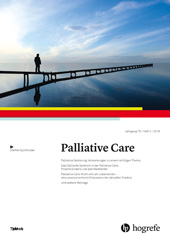Pädiatrische Palliative Care: was ist bei Kindern anders als bei Erwachsenen?
Abstract
Zusammenfassung. Die Anzahl von Kindern und Jugendlichen (0 – 18 Jahre) mit lebenslimitierenden Erkrankungen und einem Bedarf für palliative Betreuung nimmt zu. Das Bewusstsein für diesen Umstand und den Bedarf hinken hingegen in der Schweiz verglichen mit anderen entwickelten Ländern hinterher. In der Schweiz kann die Anzahl von Kindern mit einem Bedarf für Palliative Care auf etwa 5’000 geschätzt werden. Dem gegenüber stehen etwa 500 Kinder (0 – 18 Jahre), die jährlich sterben. Die häufigsten Todesursachen sind Krankheiten und Geburtskomplikationen des Neugeborenen, die in den ersten vier Lebenswochen zum Tod führen, Folgen von Unfällen und eine Vielzahl lebenslimitierender Krankheiten. Im Vergleich zu Erwachsen zeichnen sich Kinder mit einem Bedarf für eine palliative Betreuung und Begleitung nicht nur durch ihre deutlich geringere Anzahl aus. In dieser Kleinheit und Seltenheit verbirgt sich eine hohe Heterogenität der Bedürfnisse, die Kinder mit palliativem Betreuungsbedarf markant von Erwachsenen unterscheidet.
Abstract. The number of children and adolescents (0 – 18 years) with life-limiting conditions and needs for paediatric palliative care (PPC) is rising. In Switzerland, the awareness for these needs lags largely behind other developed countries. In the United Kingdom, the prevalence for children with life-limiting conditions and PPC needs was estimated at 32 children per 10’000 population (0 – 19 years). In Switzerland, this would correspond to an absolute number of 5’000 children living with a life-limiting condition and potentially in need of PPC. In contrast, the number of deaths accounts for around 500 children (0 – 18 years) every year. Most common causes of death are perinatal conditions, contributing to nearly 50 % of all deaths in childhood, followed by accidents and complex chronic conditions such as genetic / congenital disorders, neurological and cardiac conditions and cancer. Compared to adults with palliative care needs, the group of children is significantly smaller but at the same time highly heterogenic. Heterogeneity relates to: the whole age continuum from neonates, infants and children to adolescents; a broad spectrum of diseases including rare diseases; a variety of needs due to age, development and the illness, e. g. needs for specialist care or technical support; various in- and outpatient settings. Paediatric care always encompasses the whole family and their particular needs. Internationally, hospital-based programmes have been developed and implemented to meet these particular needs of children and their families.



